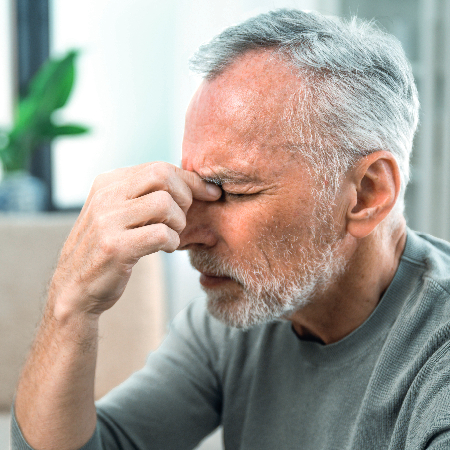Case study
Harry, aged 54 years, comes into the pharmacy and tells you that he has recently had a cold. He thought he was over it, but for the last few days has suffered from nasal congestion and facial pain. What do you advise?
1. What other clinical features are consistent with a diagnosis of acute sinusitis?
a. Eye pain
b. Reduction in sense of smell
c. Facial pain
d. Headache
2. You examine Harry and diagnose acute sinusitis. Which of the following are appropriate management options at this stage?
a. Offer empirical antibiotic treatment
b. Advise Harry to use steam inhalation
c. Advise Harry to use oral decongestants
d. Explain that it takes 2-3 weeks to resolve, and most people will get better without antibiotics
3. You advise Harry that most people get better within a few weeks and that antibiotics are not usually required. What information and advice are appropriate to give Harry?
a. A trial of nasal irrigation with saline solution may help
b. Oral analgesics can help relieve symptoms
c. Oral antihistamines can help relieve symptoms
d. He should return if his symptoms do not improve or if they deteriorate
4. Harry agrees to take paracetamol to relieve the discomfort. However, he returns after a week as his symptoms are getting worse. Which of the following are suitable first-line management options?
a. Offer an oral antibiotic
b. Offer a 14-day course of mometasone intranasal spray
c. Offer an oral antibiotic plus nasal corticosteroid
5. Which antibiotic should be offered first-line for people with acute sinusitis?
a. Cefalexin
b. Phenoxymethylpenicillin
c. Clarithromycin
d. Erythromycin
6. What information and advice should be given to people with acute sinusitis?
a. To seek medical advice if they develop any red flag symptoms
b. Symptoms should start to improve within 3-5 days of starting the antibiotics
c. To seek medical advice if there is no improvement 10 days after completing the course of antibiotics
d. To seek medical help if symptoms worsen rapidly or significantly at any time
7. If bacterial infection is not suspected, when should people return to the pharmacy for reassessment if symptoms do not improve?
a. Within 2 days
b. Within 5 days
c. Within 7 days
d. Within 10 days
8. Which of the following are exclusion criteria for these PGDs?
a. Severely immunosuppressed
b. Immunosuppressed
c. Aged under 12 years
d. Persistent symptoms despite use of high dose nasal corticosteroid
9. Which clinical features should lead to suspicion of bacterial sinusitis?
a. Symptoms lasting more than 5 days
b. Fever higher than 38˚C
c. Severe local pain
d. Discoloured nasal discharge
Answers on following screen.
Case study and questions provided by Agilio, author of NICE Clinical Knowledge Summaries (CKS), which has developed free Pharmacy First e-learning courses. Register here to complete each course.

